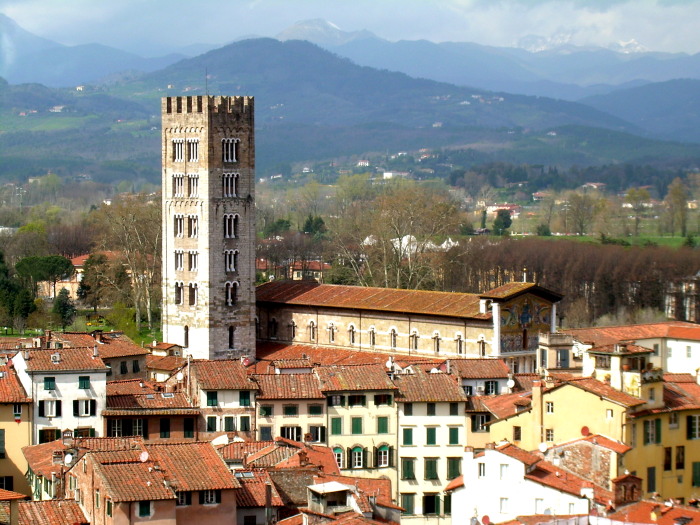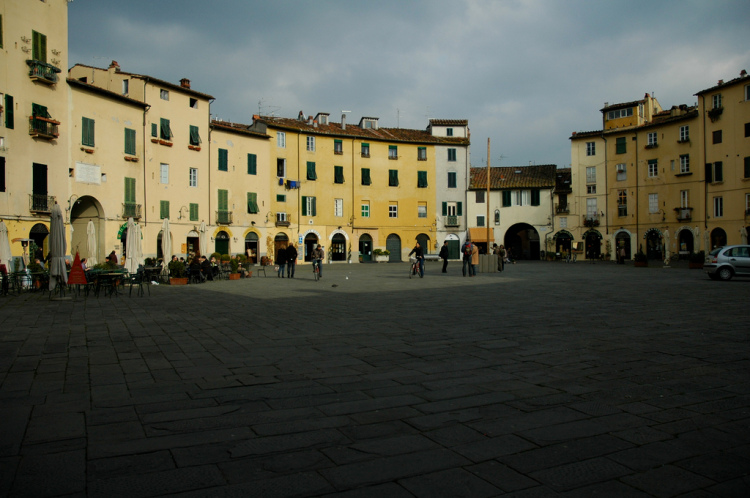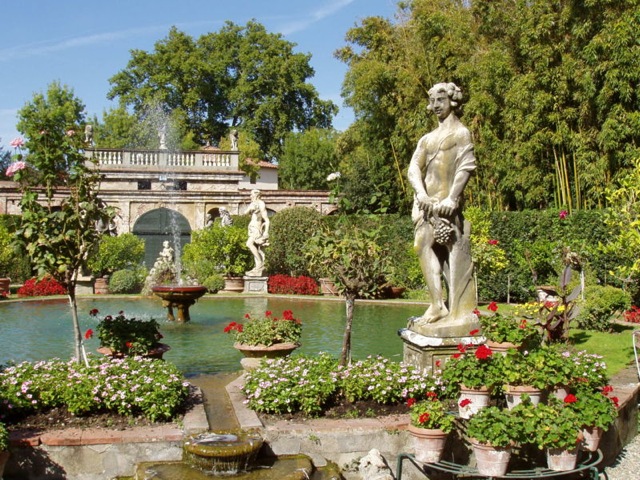
Florence beckons with world-class art collections, and Pisa with its celebrated leaning tower. Lucca offers something different: a unique medieval city built on Roman foundations, attractive to tourists but never crowded, small enough to get to know easily, yet with texture enough to satisfy the curious historian, the student of architecture, the restless explorer, the voracious gastronome, and the insatiable wine enthusiast in all of us. In addition to some of the best restaurants in Tuscany—and we'll give you our list of recommendations on request—here are just a few of the sights you can walk to:
Cathedral of San Martino
As you enter the city walls coming from the train station, Lucca's Cathedral will be the first thing you see. It was built in the local Romanesque style between the 11th and 15th centuries and continues to be in use. A twelfth century labyrinth in stone marks the entrance, leading the way to an interior packed with painting and sculpture. Inside a shrine by Matteo Civitali stands the Volto Santo, a large wooden crucifix that, according to legend, was made by contemporaries of Christ. The Volto Santo was considered the true king of Lucca during its time as an independent republic. Every year, it is still brought out to lead a procession through the city on September 13th.
The sacristy, on the south side of the Duomo, is home to Jacopo della Quercia's 15th-century masterpiece, the tomb of Ilaria del Caretto. It captures in white marble the beauty of Paolo Guinigi's second wife, who died in childbirth at only 26 years old.
Basilica of San Frediano
On the north side of town, San Frediano was built mainly during the twelfth century and named after a sixth century Lucchesi bishop. Its most striking feature is the 13th century golden mosaic that caps the facade, portraying the ascension of Christ. Inside, in a glass coffin, is displayed the body of Santa Zita, a local 14th-century serving girl whose miracles are celebrated every spring in a flower festival.
Church of San Michele in Foro
Built over the city's former Roman forum ("in Foro"), San Michele is a spectacular example of twelfth century Romanesque style. The facade's stacked arches are capped with a sculpture of the Archangel Michael. From up there, it looks down on one of the city's busiest squares, host to an outdoor flea market, street musicians, and cafés.
Giacomo Puccini house
Pay homage to Lucca's favorite son, the composer Puccini, by visiting his birthplace. Though he left the city early in life to pursue an career in opera, it has welcomed him back with open arms, hosting a year-round music festival in his honor with nightly concerts in the church of San Giovanni, under the name Puccini e la sua Lucca. For serious opera fans, the Fondazione Festival Pucciniano puts on world class performances of Puccini operas are given each summer in an outdoor amphitheater overlooking nearby Lago di Massociucoli, near the site of the composer's summer home.
Piazza Anfiteatro
Lucca's most recognizable piazza retains the oval shape of the Roman amphitheater. Ancient foundations continue in use as supports for the medieval buildings that now surround the open center. A few steps north from the market near our apartment, the Anfiteatro is a pleasant place to enjoy a morning cappuccino or an afternoon cocktail. Choose from one of the several cafés with tables spread across the piazza. One of our favorite housewares stores is there as well, Mamma Ro, with the vaulted ceilings of the Roman structure still visible in the basement.
Orto Botanico
Located near the wall by the church of San Francesco, the city's Botanical Garden is full of rare plant species, split between an outdoor garden and a greenhouse. Also on the grounds are laboratories and a botanical school. During the warmer months, it is open every day, and at other times, on weekday mornings.
Palazzo Pfanner
Dating to the 17th and 18th centuries, this palace is best known for its elegant formal gardens, which are visible from the city walls and open to the public. Inside, the palace features frescoes by Scorsini and De Santi and a collection of antique surgical instruments collected by its namesake, Dr. Pietro Pfanner.
Italian Museum of Comics
Since 2001, the Museo Nazionale del Fumetto e dell'Immagine has helped to make Lucca a national center for graphic arts. Every autumn, the city plays host to a comics and games festival.





